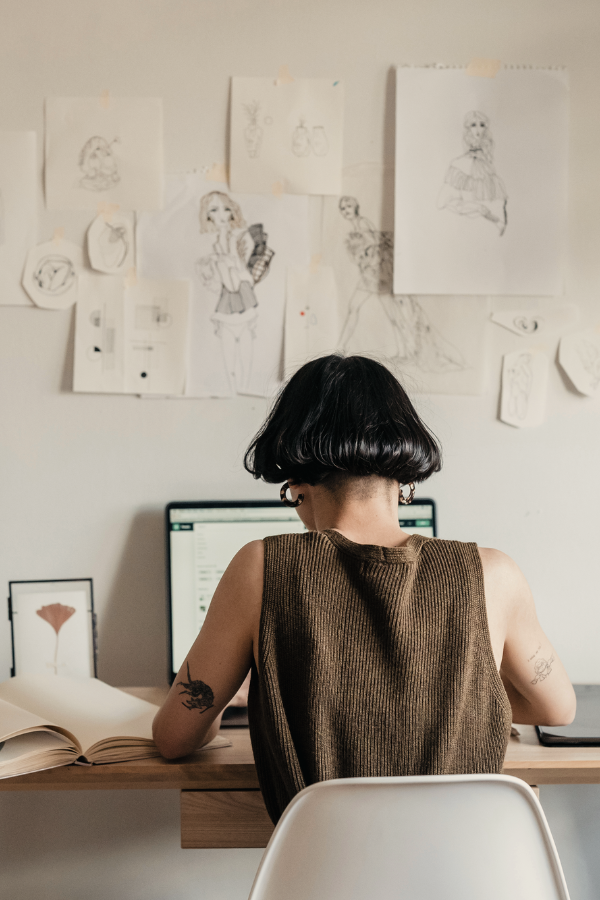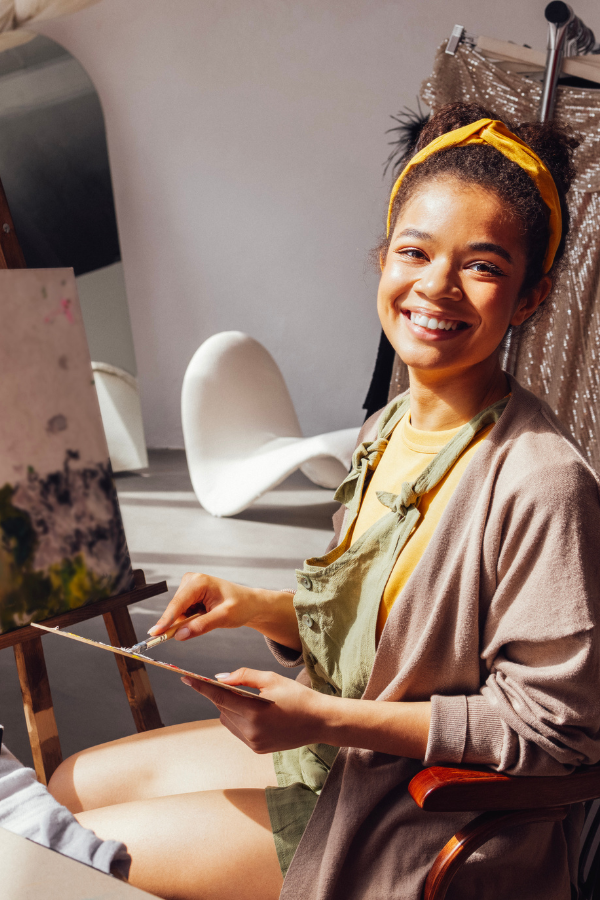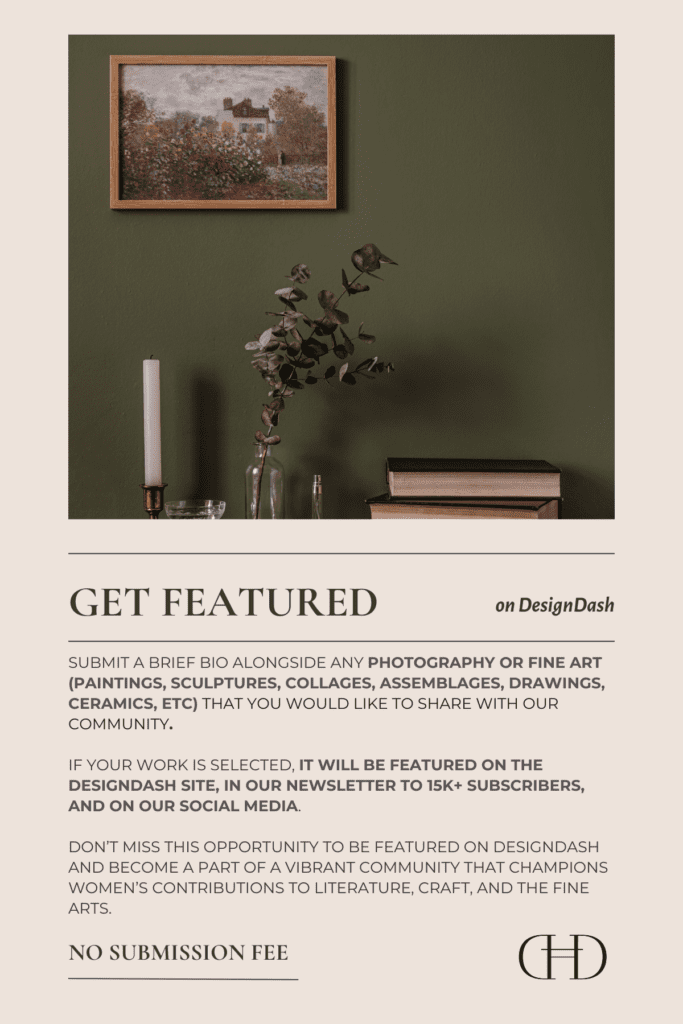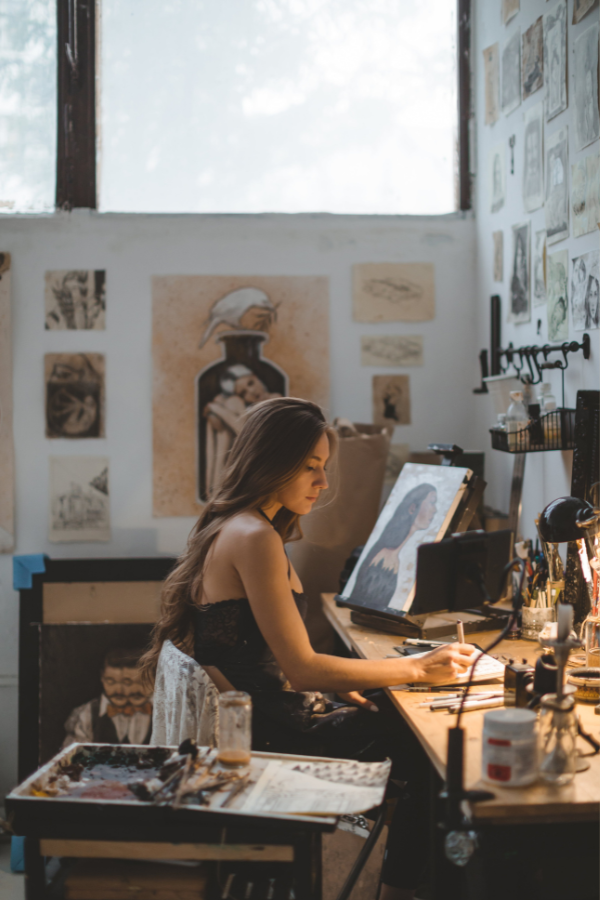

Our Online Art Portfolio Tips to Elevate Your Web Presence
Summary
Creating a compelling online art portfolio and exhibition is essential for artists in the digital age. It involves defining your artistic identity, selecting works that best showcase your abilities, and designing a user-friendly website. Enhancing your online presence with SEO, social media, interactive elements, and multimedia can significantly increase your visibility and engagement with audiences. Regular updates and the use of analytics are crucial for maintaining the relevance of your portfolio. A well-maintained online portfolio is a powerful tool for connecting with potential collaborators, galleries, and buyers worldwide.
Reflection Questions
- How does your current online portfolio reflect your artistic identity, and in what ways could it be improved to more accurately represent your vision and style?
- What strategies can you implement to increase engagement with your audience online, and how might this impact your growth as an artist?
- Reflect on the role of technology in art presentation. How do you balance the traditional aspects of your art with the innovative possibilities of digital exhibition?
Journal Prompt
Reflect on your journey of creating or enhancing your online art portfolio. Consider the challenges you faced, the successes you achieved, and the insights you gained about presenting your art in the digital realm. How has this process influenced your perspective on the value of digital engagement for artists? Write about your future aspirations for your online presence and the steps you plan to take to continue evolving and refining your digital exhibition space.
Every painter, ceramicist, illustrator, and sculptor needs an online art portfolio. Whether you are seeking a job as an art teacher or launching your art career with your first exhibition, it’s a necessity! Particularly for female artists, who have historically faced significant barriers to entry in fine arts galleries and exhibitions, a great digital portfolio can help level the playing field. It allows them to showcase their talent, narratives, and artistic expressions directly to art enthusiasts, collectors, and potential collaborators without the gatekeeping often encountered in conventional art spaces. This shift towards digital platforms not only democratizes the visibility of artists but also fosters a more inclusive and diverse art community. By leveraging the power of online portfolios and exhibitions, female artists can gain greater control over their artistic presentation and narrative, engaging with audiences on their terms and on a scale that was previously unimaginable. Read on for our top tips to create a top tier art portfolio website that helps promote your work as a professional artist.
Here’s What Every Visual Artist Should Include on Her Art Portfolio Website


Creating an engaging and professional online art portfolio is essential for artists looking to showcase their work and connect with potential clients or galleries. At its core, a compelling portfolio begins with a personal introduction, including a brief biography that outlines your background, such as your education, artistic experiences, and any recognitions or awards you’ve garnered over the years. Accompanying this should be an artist statement—a succinct narrative that delves into your artistic methods, the themes you explore, and the inspirations behind your creations, offering viewers a deeper understanding of your work and the motivations behind it.
Whether you are creating a portfolio to apply to art school, a college art portfolio for gallery shows, or a professional one, each portfolio should be visually appealing. It must include high-quality photos of your diverse range of artwork, presented with utmost clarity to capture the viewer’s attention and accurately reflect the nuances of your pieces. Each piece should be photographed professionally, ensuring that the lighting showcases the work effectively and that there are no distractions in the background. Alongside each image, it’s important to provide essential details such as the title, medium, dimensions, and the year it was created. Adding a short description of your artistic practice or the story behind each piece can enrich the viewer’s experience, offering insight into your creative process.


are you a fine artist or photographer?
Organizing your portfolio into categories or collections based on medium, style, or theme helps visitors navigate your work more easily, allowing them to appreciate the breadth of your talent. Highlighting your best or most recent works prominently ensures that the first impression is impactful. Lastly, making your contact information readily available encourages potential clients or collaborators to reach out, bridging the gap between viewing and engagement. Including links to your social media profiles not only extends the conversation beyond your portfolio but also demonstrates your active participation in the broader art community. Together, these elements combine to create an online art portfolio that not only showcases your technical skills and artistic vision but also invites deeper connections with the art world at large.
Don’t worry, we’ll delve deeper into how to organize and present your artist portfolio below!
Planning Online Art Portfolios


Crafting an online portfolio begins with the essential step of defining your artistic identity, a process that involves deep introspection about what distinguishes your art from others. This is about more than just the style or medium you work with; it’s about understanding the core themes, messages, and emotions that permeate your creations. Communicating your unique artistic vision effectively requires you to articulate these elements in your artist statement and through the selection of works you choose to display. This narrative not only introduces you to your audience but also invites them into your world, offering a lens through which they can view and interpret your work.
Selecting Pieces to Include in Your Portfolio
When it comes to selecting your best work for your portfolio, the focus should be on quality over quantity. Choose pieces that showcase your technical skills, artistic range, and the themes you’re most passionate about. Consider including works that have been well-received by audiences or have personal significance to your growth as an artist. Each piece should contribute to the overall narrative you want your portfolio to tell, ensuring a cohesive presentation that captures the essence of your artistic journey.
Arranging your work to narrate your artistic journey is akin to storytelling, where each piece acts as a chapter in your larger narrative. The order and manner in which you present your work can significantly impact the viewer’s experience, guiding them through your evolution as an artist. Consider organizing your portfolio in a way that reflects chronological development or groups works by theme or technique. This not only provides context to your audience but also demonstrates your versatility and depth as an artist. Engaging viewers with a story not only about the art itself but also about the journey behind it, creates a more memorable and impactful experience, encouraging deeper connections with your work.
Our Top Tips for Designing Your Online Portfolio
Selecting the right platform for your online portfolio is a critical decision that can significantly impact how your work is perceived and engaged with by viewers. With a plethora of options available, from specialized art portfolio websites like Behance and ArtStation to more customizable platforms like Squarespace and WordPress, the choice depends on your specific needs and technical comfort level. Consider factors such as ease of use, the ability to customize the design to fit your artistic identity, and the platform’s audience.
Some platforms cater more to certain types of visual arts or industry professionals, so think about where your work is most likely to resonate. Additionally, consider the platform’s features, such as the ability to sell your work directly, integration with social media, and analytics tools to track viewer engagement. The former might not be necessary when creating an art school portfolio but could be indispensable when transitioning to a professional career. Making an informed choice ensures your portfolio not only showcases your art in the best light but also reaches your target audience effectively.
Layout and Design Principles
The layout and design of your online portfolio play a crucial role in ensuring a positive user experience, encouraging viewers to explore your work in depth. Best practices in portfolio design include maintaining a clean and clutter-free layout that focuses attention on your art, using a consistent color scheme and typography that complements rather than competes with your artwork, and ensuring easy navigation with clear categories or sections.
It’s also important to design responsively, ensuring your portfolio looks great and functions well on devices of all sizes, from desktop computers to smartphones. The goal is to create a visually appealing and intuitive interface that makes viewing your art a pleasure, thereby increasing the likelihood of engaging potential clients, galleries, or collaborators.
Incorporating High-Quality Images
Incorporating high-quality images into your online portfolio is non-negotiable for making a strong impression. The quality of your images directly affects how your artistic process is perceived; thus, ensuring each piece is photographed or scanned with high resolution and good lighting is imperative. This may involve investing in a professional camera or hiring a photographer skilled in art reproduction. Pay attention to framing each piece to avoid glare or distortion, and consider editing images to accurately represent the colors and textures of the original work.
Additionally, optimizing images for web use without sacrificing quality is essential to ensure fast loading times, enhancing the viewer’s experience. High-quality images not only show your work in its best light but also convey your professionalism and attention to detail, key factors in building trust and interest among viewers and potential clients.
Adding Interactive Elements
Integrating interactive elements into your online exhibition can transform a static viewing experience into an engaging, immersive journey for your audience. Virtual tours and augmented reality (AR) experiences allow viewers to explore your artwork in a more dynamic and intimate way, mimicking the experience of walking through a physical gallery.
For example, virtual tours can guide visitors through curated collections of your work, offering insights or stories behind each piece. Augmented reality, on the other hand, can enable viewers to see how a piece of art would look in their own space, enhancing their connection to the work and potentially increasing their likelihood to purchase. These interactive features not only make your art more accessible but also significantly enrich the viewer’s engagement, setting your online portfolio apart from the traditional scroll-through gallery.
Incorporating Multimedia
The use of multimedia elements, such as videos, artist interviews, and process demonstrations, adds a rich layer of depth to your online exhibition. Videos of your artwork, especially those that capture the texture and detail of your pieces, can offer a closer look that still images might not convey.
Artist interviews provide a personal touch, allowing viewers to connect with you and your artistic journey on a deeper level. Process demonstrations, whether they show the creation of a piece from start to finish or highlight particular techniques, offer fascinating insights into your craft. These elements invite the viewer into your world, offering a behind-the-scenes look at your creative process and further personalizing the experience of your online portfolio.
Integrating with Social Media Accounts
Effectively leveraging social media platforms is crucial for expanding the reach of your online exhibition and engaging with a wider audience. Integrating your portfolio with social media allows for easy sharing of your work, encouraging viewers to spread the word about your art. Including direct links to your social media profiles within your portfolio not only facilitates this sharing but also helps build your following across platforms.
Utilizing social media can drive traffic back to your portfolio, where more detailed work and contact information are available. Additionally, engaging with your audience through social media—whether through regular updates, live Q&A sessions, or behind-the-scenes content—can foster a community around your work, enhancing viewer investment and interest in your artistic journey.
Investing in SEO
Mastering the art of SEO begins with understanding the power of targeted keywords and compelling descriptions for artists looking to enhance their online portfolio’s search engine ranking. Keywords are the terms and phrases that potential collectors, galleries, and art enthusiasts might use when searching for art online.
By strategically incorporating these keywords into the titles, descriptions, and even the alt text of images in your portfolio, you make it easier for search engines to understand and categorize your content, thereby increasing the chances of your work appearing in relevant search results. Crafting compelling descriptions involves more than just keyword stuffing.
It’s about creating informative and engaging text that provides value to the reader while naturally integrating your chosen keywords. This dual approach not only improves your portfolio’s visibility but also enhances the user experience for visitors, encouraging them to engage more deeply with your work.
Online Visibility
Increasing the online visibility of your art portfolio requires a multi-faceted strategy that extends beyond the confines of your website. One effective approach is to create a network of links between your portfolio and other websites, such as art blogs, online galleries, and social media platforms. This not only drives traffic to your portfolio from diverse sources but also improves your site’s ranking in search engine results through backlinking, a key factor in SEO performance.
Engaging with online art communities, participating in virtual exhibitions, and regularly updating your social media profiles with links back to your portfolio are all ways to expand your digital footprint and attract more visitors. Additionally, listing your portfolio on artist directories and leveraging online platforms that feature artists can introduce your work to new audiences. By adopting a holistic approach to online visibility, you can significantly increase the reach and impact of your online art portfolio, connecting with more fans, collectors, and opportunities in the digital art world.
Engaging with Your Audience


Creating a dialogue with your audience is an integral part of building a vibrant online presence as an artist. Encouraging feedback and interaction through comments, contact forms, or social media can transform your portfolio from a static collection of works into a dynamic community hub. Such engagement not only enriches the viewer’s experience by allowing them to participate in the conversation but also provides you with valuable insights into your audience’s preferences and perceptions.
Implementing interactive features on your website, such as a guestbook or a comment section, and being active and responsive on social media platforms, encourages this two-way communication. Regularly inviting feedback on new projects or pieces can foster a sense of community and belonging among followers, making them feel like part of your artistic journey. This level of engagement not only bolsters your relationship with existing fans but can also attract new followers who are drawn to the inclusive and interactive nature of your online space.
Networking and Collaborations
Your online portfolio is not just a showcase of your work; it’s a powerful networking tool that can open doors to new opportunities and collaborations. Actively using your portfolio to connect with other artists, galleries, and potential buyers can significantly expand your professional network.
By highlighting collaborative projects or featuring guest posts from fellow artists, you can create a sense of community and shared purpose within your portfolio. Participating in online forums, art contests, and virtual exhibitions increases your visibility within the art community, making it easier to forge meaningful connections. These interactions can lead to collaborative projects, exhibitions, or even representation by galleries.
Networking through your online portfolio can also attract the attention of collectors and art enthusiasts, potentially leading to sales and commissions. By positioning your portfolio as a nexus for collaboration and connection, you not only enhance your own artistic career but also contribute to the broader art community.
Maintaining and Updating Your Portfolio
Keeping your online portfolio fresh and up-to-date is crucial for capturing and retaining the interest of viewers and potential collaborators. Regularly adding new work and removing older or less representative pieces ensures that your portfolio accurately reflects your artistic growth and abilities. This practice demonstrates your commitment to your craft and shows that you are actively creating and evolving as an artist.
An updated portfolio is also more likely to engage repeat visitors, encouraging them to check back regularly to see new pieces and follow your progress. Additionally, consistently refreshing your content can improve your website’s SEO, making it more visible in search engine results and attracting a wider audience. In the dynamic world of art, staying current and active through your portfolio can make the difference in capturing the attention of galleries, collectors, and fellow artists.
Analytics and Adaptation
Utilizing analytics tools to monitor how visitors interact with your online portfolio offers invaluable insights that can guide improvements and adaptations for better engagement. By analyzing data such as page views, bounce rates, and the paths visitors take through your site, you can identify which pieces are most engaging, which pages may need refinement, and where visitors lose interest. This information allows you to make informed decisions about layout changes, content updates, and even which new works to prioritize for inclusion.
Additionally, understanding the demographics and behavior of your audience can help tailor your marketing and social media strategies to better connect with your target viewers. Adapting your portfolio based on analytics not only optimizes the visitor experience but also ensures that your online presence is as effective and engaging as possible, helping to grow your audience and increase opportunities for exposure and sales.
Final Thoughts for Building an Art Portfolio Online


As the digital landscape continues to expand and transform, so too should your online presence. Encouraged by the endless possibilities that digital innovation offers, you are invited to continually evolve and refine your online portfolio. By staying attuned to new trends, seeking feedback, and embracing the journey of growth, your online exhibition can flourish, ensuring that your art resonates with audiences far and wide and opens doors to new opportunities and discoveries in the ever-changing world of art.








